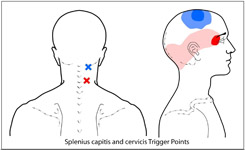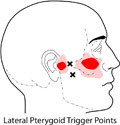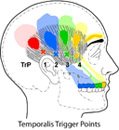As a Neuromuscular Therapist, how do I think about chronic headache pain?


If medical reasons for headaches have been ruled out, the cause is probably muscular Trigger Points. Examining the muscles in the neck and shoulders usually turns up at least one cause. But finding unhealthy muscles with Trigger Points is only targeting the symptoms. The root cause is the puzzle to figure out. Why are the muscles so tight that they have developed Trigger Points in the first place? Outside of the realm of medical problems, the four most common initiators of headache pain from the muscles are stress, posture, structural asymmetries and TMJ dysfunction.
Stress can quickly cause muscle tension. Think of the startle position of an infant with the shoulders and arms raised. It’s an instinctive muscle reaction. Maybe think of yourself as a turtle going into its shell to avoid something disturbing. Chronic stress causes chronic tension.
Posture is a big contributor to muscle tension. Our relaxed American posture is slumped with the head forward. If you kept your head in that position and straightened your back, you’d find yourself looking at the sky! When your head is forward, gravity acts on it, increasing its weight and therefor the work the muscles have to do to hold it up.
Structural asymmetries like a scoliosis or a lower limb length inequality (LLLI) can tilt the shoulder girdle resulting in one-sided neck and shoulder tension. If corrections aren’t made to a structural imbalance, the resulting tension in the muscles can produce Trigger Points that can cause headaches.
TMJ (temperomandibular joint) dysfunction frequently causes headaches. The jaw is a moveable joint controlled by muscles. When there is misalignment in the jaw it can fire off the nerves in the joint and cause pain. The misalignment can also cause muscle tension that can lead to Trigger Points. The illustrations are for the Trigger Points from the masseter, lateral pterygoid and temporalis muscles of the jaw.



Trigger Points: Of the many muscles in the neck that can cause headaches, the suboccipitals, upper trapezius, splenius and SCM (sternocleidomastoid) are the most frequent culprits. Treatment of these muscles to reduce Trigger Point activity can help immediately. However, perpetuating factors like stress, posture, sleeping habits, TMJ and uncorrected structural imbalances can bring the headaches back.
Also consider these three things: The younger you are the more quickly you’ll recover. The longer your headaches have persisted, the longer it will take to get relief. If you have had more than two accidents involving your neck, it will be more difficult to get well.
Helo i sometimes have anxiety nd feeling pain on top of my head down to the neck …..Can you pls help
Hello, There are only two muscles harboring Trigger Points that refer to the top of the head (called the Vertex). The Sternocleidomastoid (SCM) attaches behind your ears to the mastoid process (a bone) and runs in two bands down to the sternum (breastbone) and the clavicle (collar bone). The Splenius Capitis attaches to the occiput (the bone at the base of the skull) right next to the attachment of the SCM and travels down to the upper spine attaching to the lowest of the cervical and uppermost of the thoracic vertebrae. The Splenius has a companion muscle, the Splenius Cervicis which attaches to the bones at the side of the neck (transverse processes) and continue the attachments of the Capitis lower on the thoracic spine.
Both Splenius muscles turn and tilt your head backward, so think about what you do with your head in that position. The Cervicis would also give you pain in the neck and at the angle of the shoulder and pain through your head to behind your eye.The SCM turns your head and keeps it from falling backward (stabilizer) and is a major cause of head and face pain.
Pressing on or compressing these muscles for several seconds helps to release the tension and relieve the headaches.